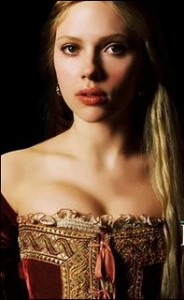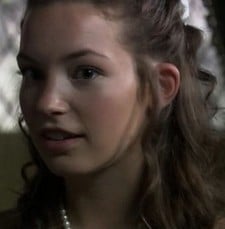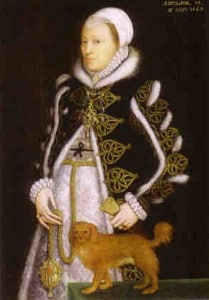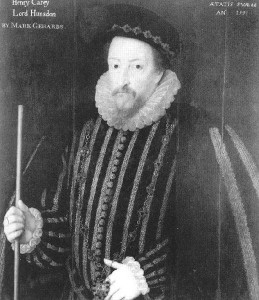
Mary Boleyn and her first husband, William Carey, had two children. Their first child, Catherine, was born in around 1524 and their second child, Henry, was born in March 1526.
I am often asked whether either or both of the Carey children were actually the King’s illegitimate offspring and it is simply impossible to answer that question because we just don’t know. We have no evidence either way and we don’t know when Mary slept with the King, only that they had a sexual relationship.
Arguments for the Careys being the King’s children
Henry Fitzhugh, who is descended from Catherine Carey, was inspired by Philippa Gregory’s “The Other Boleyn Girl” to dig around into his family’s past. He wrote an article1 on his findings in which he argued that the Carey children were fathered by Henry VIII because:-
- Henry Carey was said to have looked like Henry VIII.
- Henry Carey claimed in 1533, at the age of seven, that he was “Our Sovereign Lord the King’s son”
- John Hale, Vicar of Isleworth, wrote in 1535 of how a monk at St Bridget’s Priory Abbey had pointed out “yongge Master Care” as being the King’s bastard son.
- The fact that Henry VIII gave Anne Boleyn the wardship of Henry Carey after the death of William Carey.
- The royal grants which William Carey received in 1524 and 1526 are thought to coincide with the birthdates of Catherine and Henry Carey. Fitzhugh is of the opinion that the King was compensating Carey for the fact that these were not his biological children and that his wife was being used by the King.
- Henry VIII admitted “affinity” and “consanguinity” with Mary Carey when he wanted a dispensation to marry her sister, Anne Boleyn, and Fitzhugh points out that this dispensation probably would not have been necessary if no children had resulted from their union.
- Both children were born during the period when some historians believe Henry VIII’s affair with Mary Boleyn to have taken place – Some believe Henry would have expected Mary to be his alone and not to have any lovers, not even her husband, and although Henry Carey may have been born after the affair ended, he was conceived during the correct time-frame.
- Elizabeth I’s relationship with the Careys – Elizabeth I was very close to Henry and Catherine Carey. Henry Carey was knighted by the Queen and made Baron Hunsdon, and Elizabeth even visited him on his deathbed, giving him the patent and robes of the Earldom of Wiltshire. Catherine Carey was one of Elizabeth’s senior ladies for many years and when she died Elizabeth gave her a lavish funeral and a prominent memorial. Josephine Wilkinson writes that Catherine’s funeral “can only be described as ‘royal’, with a cost of £640 2s 11d”2 and writes that one explanation for this considerable sum being spent on Catherine’s funeral is that the two women were half-sisters.
Robert Carey, Henry Carey’s grandson was with Elizabeth I when she died and it is said that he was the one who received the ring taken from the Queen’s hand.
In an article entitled “Sir Francis Knollys’s Latin dictionary: new evidence for Katherine Carey”3, Sally Varlow argues the fact that Catherine Carey could have been Henry VIII’s daughter. She explains that Sir Francis Knollys recorded the birth dates of his 14 (some say 15) children in his Latin dictionary and that his notes regarding his wife’s pregnancies, when linked with other historical evidence (such as portraits of Catherine), suggest that his wife was born between 1523 and 1525, inside the period when Mary is traditionally believed to have been the King’s mistress. A birth date during that time would also confer with Catherine becoming maid-of-honour in 1539 for the coming queen, Anne of Cleves, as most girls chosen for this position were aged over 16.
Like Fitzhugh, Varlow believes that Henry VIII would not have liked sharing Mary Carey with another man, even her husband, so if Catherine Carey was born between 1523 and 1525, she believes that she must surely have been the King’s daughter. Varlow also tackles one of the arguments against the Carey children being the King’s, the fact that Henry VIII did not recognise them as his, by saying that the King did not have anything to gain by recognizing them. He already had Henry Fitzroy, the illegitimate son he’d had with Bessie Blount, and he obviously hoped to have a legitimate heir to the throne. Josephine Wilkinson also argues that Henry Carey was born around the time that Henry VIII was becoming involved with Anne Boleyn so it would have caused a scandal if Henry had acknowledged her sister’s child as his own.

Josephine Wilkinson4 points out that a portrait of Catherine Carey painted in 1562 notes that the sitter was aged 38, giving Catherine a birthdate of 1524, and she also points out that although Henry Carey was born after Henry VIII’s affair with Mary is thought to have ended – 4th March 1526 – conception would have taken place around June 1525 when Mary was still the King’s mistress.
Wilkinson gives further circumstantial evidence for the children being the King’s:-
- The Venetian ambassador, Ludovico Falias, wrote in November 1531 that the King had a “natural son born to him of the widow of one of his Peers; a youth of great promise, so much does he resemble his father.”5 This, as Wilkinson points out, could refer to Henry Carey or Henry Fitzroy as both their mothers had been widowed by this time.
- The dates of William Carey’s royal grants – Wilkinson writes that “most of the royal grants awarded to William Carey are concentrated on the dates that coincide with the birth of Mary’s children.” For example, on the 15th June 1524, Carey was made keeper of Wanstead Manor and on the 18th June he and Mary were awarded the grant of several manors in Essex. Then on the 20th February 1526, shortly before Henry Carey’s birth, Carey was granted several manors in Buckinghamshire. William Carey was also retained in Henry VIII’s service following the Eltham purge of January 1526 and Wilkinson writes that “to retain her husband in a post was one way of ensuring financial security and stability for the family as well as providing a means of rewarding Carey for his complaisance.”6
Arguments against the Careys being the King’s children
- Henry VIII’s fertility problems – In “The Life and Death of Anne Boleyn”, Eric Ives writes that “It may also be relevant to note the long delay before she became pregnant, something which might be expected of a period when she was taken up with a man of such known low fertility as Henry VIII… Once Mary had begun to cohabit with William Carey, her two children came in quick succession”7. This all depends on when the affair started, how long it lasted and whether Mary was, at one point, sleeping only with the King. This could explain why she did not get pregnant before 1523/4.
Josephine Wilkinson also writes of Henry’s low fertility, saying “of the eight women with whom he had sexual relations, or was presumed to have had, only four managed to conceive and carry their baby successfully.”8 However, Wilkinson also points out that Henry’s problems could have been due to the psychological pressure to produce a male heir, a pressure and anxiety that he may not have felt when with his mistress. - Henry VIII did not recognise the Careys as his – Some historians, including Antonia Fraser, argue that Henry VIII never recognised Henry Carey as his illegitimate son and did not show him any favour, whereas Bessie Blount’s son was given the surname “Fitzroy”, “son of the King”, and the title Duke of Richmond.
- Elizabeth I wrote of the Careys as her cousins and did not refer to them as brother and sister. Her kindness to them could be simply because they were her cousins and were a link to her mother, Anne Boleyn.
- There is no evidence that the Careys were Henry VIII’s illegitimate offspring and we don’t even know when Henry VIII slept with Mary or how long their relationship lasted.
In “Mary Boleyn”, Josephine Wilkinson examines the many arguments for and against Henry VIII being the father of the Carey children and writes:
“… there is no tangible proof to say that he was their father. However, when circumstantial evidence is taken into account, the chances that Mary’s children were fathered by Henry rather than William Carey greatly increase.”9
She concludes that although the evidence in support of Henry being the Carey children’s father is not conclusive, it does outweigh the arguments and evidence against and so it is highly probable that Henry VIII was the father of Catherine and Henry Carey.
My own personal view is that the Carey children were fathered by William Carey. We have no details of Mary’s relationship with the King. We only know that they had a sexual relationship because of the fact that the King applied for a dispensation from the Pope in 1527 to enable him to marry Anne Boleyn and in this dispensation was listed the impediment of “affinity arising from illicit intercourse in whatever degree, even the first” (there was the impediment of affinity in the first degree due to Henry having slept with Anne’s sister). Mary could well have been just a one night stand when Elizabeth Blount, the King’s former mistress, was pregnant with the King’s son in 1519, they may not have had a long-lasting affair at all. Alternatively, they may have had a longer lasting relationship. We just don’t know.
Catherine Carey, Lady Knollys

Catherine Carey was born around 1524. We do not know anything about her early life but Alison Weir is convinced that stories that the 12 year old Catherine attended her aunt, Anne Boleyn, in the Tower and was present at her execution are false. Catherine crops up in the records in 1540 when, at the age of 16, she becomes a maid-of-honour to Anne of Cleves. In that same year, on the 26th April 1540, Catherine married Francis Knollys, a favourite at Henry VIII’s court and one of the men sent in 1539 to attend Anne of Cleves on her arrival in England.
After the annulment of the Anne of Cleves marriage, Catherine went on to become maid-of-honour to Catherine Howard. Her husband became an MP in 1542, was knighted in 1547 during Edward VI’s reign and became a good friend of the Protestant William Cecil. The Knollys’ Protestant beliefs led to them leaving England in 1553 when the Catholic Mary I came to the throne and living in exile in Germany. In 1558, Catherine and Francis returned to England and Francis became a member of Elizabeth I’s privy council and then Vice-Chamberlain of the Household and Captain of the Halberdiers. Catherine became one of Elizabeth’s ladies of the privy chamber, serving her cousin (or half-sister!) as the Chief Lady of the Bedchamber.
Catherine’s husband continued to rise at court, holding many state office and being one of the men that Elizabeth trusted to take charge of Mary Queen of Scots at Carlisle Castle in 1568. In the 1580s he was a commissioner for the trials of Anthony Babington, Mary Queen of Scots and Philip Howard, Earl of Arundel. During the Spanish Armada, Knollys was placed in charge of the land troops in Hertfordshire and Cambridgeshire. Knollys was a devout Protestant.
Sir Francis Knollys and Lady Catherine Knollys had a total of 15 children including:-
- Lettice Knollys (1543 – 1634) – Lettice was married three times: Walter Devereux, 1st Earl of Essex, Robert Dudley, 1st Earl of Leicester, and then Sir Christopher Blount. After Elizabeth I heard of Lettice’s marriage to Dudley, she nick-named Lettice “the she-wolf”.
- Elizabeth Knollys – Wife of Thomas Leighton, Governor of Guernsey, and the ancestor of Prince William and his girlfriend Kate Middleton – see Prince William, Kate Middleton and Mary Boleyn.
- William Knollys (c1544 – 1632) – The 1st Earl of Banbury.
- Sir Robert Knollys (1547 – 1626) – His offices included Usher of the Mint, Gentleman of the Privy Chamber and Keeper of Sion House.
Catherine served her queen up until her death on the 15th January 1569 at Hampton Court Palace, having been taken ill in late 1568. Elizabeth I gave her good friend a lavish funeral and Catherine was buried in St Edmund’s Chapel, Westminster Abbey. According to wikipedia, her epitaph reads:-
“The Right Honourable Lady Katherine Knollys, chief Lady of the Queen’s Majesty’s Bedchamber, and Wife to Sir Francis Knollys, Knight, Treasurer of Her Highnesses Houshold, departed this Life the Fifteenth of January, 1568*, at Hampton-Court, and was honourably buried in the Floor of this Chapel.
This Lady Knollys, and the Lord Hunsdon her Brother, were the Children of William Caree, Esq; and of the Lady Mary his Wife, one of the Daughters and Heirs to Thomas Bulleyne, Earl of Wiltshire and Ormonde; which Lady Mary was Sister to Anne Queen of England, Wife to K. Henry the Eighth, Father and Mother to Elizabeth Queen of England”10
Catherine is also remembered in the Knollys Chapel of St Nicholas’ Parish Church, Rotherfield Greys in Oxfordshire, where there is a Knollys family tomb with effigies of Sir Francis and Catherine Knollys.

Henry Carey, 1st Baron Hunsdon
Henry Carey was born on the 4th March 1526. After the death if his father, Sir William Carey, in 1528, the two year old Henry was put under the wardship of his aunt, Anne Boleyn. Anne ensured that Henry had a good education and he received education at a Cistercian monastery and also under the tutelage of the French poet, Nicholas Bourbon. His ward, Anne Boleyn, was executed in 1536 when Henry was 10 and then his mother died in 1543. Two years after his mother’s death, on the 21st May 1545, Henry married Anne Morgan.
Henry Carey became a Member of Parliament in 1547, was knighted in 1558 and then made 1st Baron Hunsdon in January 1559. On the 31st October 1560, Elizabeth I made him her Master of the Queen’s Hawks and then a Knight of the Garter in April 1561. Other offices held by Henry include Lieutenant General (during the Rising of the North 1569-70), Warden of the East Marches (1571), Keeper of Somerset House (1574), Privy Counsellor (1577), Captain General (1581), Lord Chamberlain of the Household (1585), Lord Chamberlain Lieutenant, Principal Captain and Governor of the Army (Tilbury 1588), Chief Justice in Eyre (1589), High Steward of Ipswich and Doncaster, Chief Justice of the Royal Forces (1591) and High Steward of Oxford (1592). In 1594, Henry Carey became the first patron of William Shakespeare’s company of actors, The Lord Chamberlain’s Men.11
In 1595, Carey’s wife, Anne, was appointed to the office of Keeper of Somerset House, a position once held by her husband, and she was also one of Elizabeth’s Ladies of the Privy Chamber. Anne and Henry had 12 children, including:-
- Sir George Carey (1547 – 1603) – 2nd Baron Hunsdon and Knight of the Garter.
- Sir John Carey (d.1617) – 3rd Baron Hunsdon and a politician.
- Robert Carey (1560 – 1639) – 1st Earl of Monmouth, diplomat and witness to the illness and death of Elizabeth I. It was Robert who rode to give the news of Elizabeth’s death to James I.
- Katherine Carey (c1547 – 1603) – Wife of Charles Howard, 1st Earl of Nottingham.
- Philadelphia Carey (c1552 – 1627) – Wife of Thomas Scrope, 10th Baron Scrope of Bolton.
Henry Carey also had a number of illegitimate children, including Valentine Carey (d.1626) who was a clergyman whose offices included Master of Christ’s College, Dean of St Paul’s and Bishop of Exeter.
Henry Carey, 1st Baron Hunsdon,died on the 23rd July 1596 at Somerset House. It is said that on his deathbed, Elizaebth I offered to give him the title Earl of Wiltshire, a title once held by his grandfather, Thomas Boleyn, but Henry refused Elizabeth’s offer, saying “Madam, as you did not count me worthy of this honour in life, then I shall account myself not worthy of it in death.”12 Henry was buried at Westminster Abbey on the 12th August 1596 in St John the Baptist’s Chapel. According to the Westminster Abbey website, his tomb is the tallest in the Abbey, measuring 36 feet in height. The Abbey website goes on to say of the tomb:-
“It is made of alabaster and marble with a considerable display of heraldry, which includes the Carey arms – argent, on a bend sable three roses of the field (ie. a silver shield with a black bar diagonally across it from top left to bottom right with three silver roses on it). His crest is a swan and his motto “Comme je trouve” (as I find it). The Latin inscription can be translated as:
“Consecrated for the burial of the Hunsdon family. Here sleeps in the Lord Henry Carey, Baron Hunsdon, one-time Governor of the town of Berwick, Warden of the east marches towards Scotland, Captain of the gentleman-pensioners, Chief Justice of the Forests south of the Trent, Knight of the Order of the Garter, Lord Chamberlain of the Lady Queen Elizabeth, sworn of the Privy Council, and first cousin to the aforesaid Queen. Together with him is buried Anne, his dearest wife, daughter of Thomas Morgan, knight, who bore him many children, of whom there survive George, John, Edmund and Robert, knights, Catherine, Countess of Nottingham, Philadelphia, Baroness Scrope, and Margaret, Lady Hoby. He died 23 July 1596 aged 71. His son, George Carey, Baron Hunsdon, member of the Order of the Garter, Captain-General of the Isle of Wight, Chamberlain of the household to Queen Elizabeth, Privy Councillor, and his wife Anne, placed this monument to the best of fathers and dearest of husbands, in his honour and memory, and being mindful of their own and their family’s mortality.”13
In tomorrow’s post I will continue with Mary Boleyn’s life story.
See also my article Mary Boleyn and Henry VIII.
*In Tudor times, the new calendar year did not start until Lady Day on 25th March so the Tudors would say that Catherine died in 1568, whereas we’d call it 1569.
Notes and Sources
- “My Granny Was A wh*re …, or, A Love Story…, or, Our Descent From Henry VIII?”
- Mary Boleyn: The True Story of Henry VIII’s Favourite Mistress, Josephine Wilkinson, p88
- “Sir Francis Knollys’s Latin dictionary: new evidence for Katherine Carey”
- Josephine Wilkinson, p79
- Ibid., p88
- Ibid., p91
- Ives, p17
- Josephine Wilkinson, p80
- Ibid., p87
- Wikipedia page on Catherine Carey
- Wikipedia page on Henry Carey
- Ibid.
- Westminster Abbey website